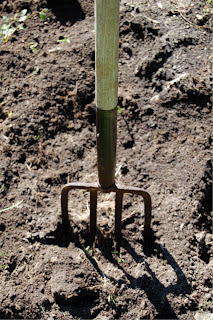~ Wednesday, April 6, 2011
Time to give your garden the once over before you get planting.
I am frequently asked; “what is the one word of advice that I can give Canadian gardeners that will ensure success”. The answer is always the same: proper soil preparation.
This is why I devoted 1/3 of my latest book, The Canadian Garden Primer An Organic Approach, to the subject.
If you have ever tried to produce a gorgeous garden in heavy clay soil, you know what I am talking about. The same is true for pure sand.
Adding generous quantities of organic matter in the form of compost makes a world of difference to most any garden.
My recipe for a great looking garden:
(Assuming that you have poor to average quality soil.)
1. Spread finished compost one to two inches thick over the planting area and around established perennials and shrubs. If your garden soil is made up mostly of heavy clay add 1/3 sharp sand (not beach sand!) to the compost.
 2. Turn the compost under using a garden fork (a fork disturbs the roots of established plants much less than that of a shovel or spade and is easier to push into your existing soil).
2. Turn the compost under using a garden fork (a fork disturbs the roots of established plants much less than that of a shovel or spade and is easier to push into your existing soil). 3. ‘Slap’ the mixed soil/compost to get rid of large clods of earth: small ones will not matter.
4. If the consistency of the newly turned soil is not ‘open’ enough to easily push a garden trowel you have three choices: add more 2/3 compost and 1/3 sand, dig it over again a couple of times or get a better trowel.
This is less work than it may seem, if you take it a step at a time (read: stop digging when your back begins to hurt) and if you don’t tear into it, but rather take a slow easy pace. In the long run you will get more done and enjoy the experience.
The goal here is to create a ‘friable’, open, rich organic based soil that is ready for planting.
In April you can plant trees, shrubs, evergreens, roses and some hardy perennials that have not been forced early in a greenhouse somewhere (these will be ‘soft’ and frost tender). Never mind if you get some frost or snow between now and the ‘traditional planting time on the long weekend of May’.
There is a myth out there that you can only plant on the May 24th weekend, but it is very misleading. For one, this rule only applies to ‘frost tender’ plants like annuals and tender vegetable plants.
Secondly, there are some tender plants that perform better in warm soil, like squash, pumpkins, corn and beans. In the flower garden I plant my impatiens last as there is nothing they like less than to have ‘cold feet’.
Finally – there are parts of the country where a late May planting of tender plants is too early – Newfoundland and the northern prairies as an example. Check with your local gardening authorities to be sure (they may be the operators of a local greenhouse, garden centre or your Home Hardware).
While we are talking about getting ready for the planting season now would be a good time to fertilize your lawn (see last weeks’ blog), sharpen your lawn mower blade and change the oil.
Oil and sharpen all of your digging tools. A bastard file does the job in most cases and a squirt of WD 40 or equivalent.
Get out your garden hose, lawn furniture, the garden ornaments that you put away for the winter and if any of these need a coat of paint, now is a great time to give them a new coat.
Keep your knees dirty!
Mark

